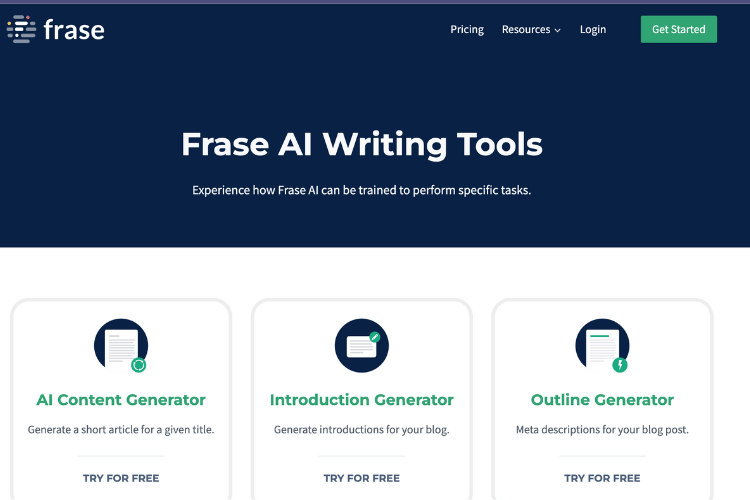Call it blue, highlighted, or anchored text—the different names won’t change the fact that it’s a powerful ranking factor. What you should focus on is how the anchor looks.
The common types of anchor text in SEO range from the basic keyword match to the bulky naked URL.
In this post, we’ll check out the main types and learn how to boost rankings without over-optimisation penalties.
9 Anchor Text Types
Let me start by saying that there isn’t one solid number of anchor types out there.
While some recognise only 6–7 primary types, others expand the list to include more variations like page title, call to action, and keyword phrase match anchors.
Here are the ones I think are worth your attention:
1. Branded
Branded anchor text refers to using a brand or product name as the link text. For example, you may link to the “Frase.io” website using nothing other than “Frase.”
As you can see, this type works well when citing a source or linking directly to a company site.
2. Branded With Keyword Matches
This anchor type isn’t all that different from the last one. However, it includes a secondary keyword with the brand/product name. It’s usually good for adding a bit of context.
One example is using “Frase AI Writing Tool” rather than just “Frase.”

I could also use an anchor like “Frase review” to add context for an internal link. This way, the reader knows exactly where this link would take them if they were to click on it.
3. Exact Match
As the name suggests, exact match anchor text mirrors the target keyword you want to rank for OR the core keyword in the linked blog article.
So, if you hope to rank for “content writing,” your anchor text would be “content writing.”
There’s a catch, though. It’s easy to fall into the trap of over-optimisation with this sort of anchor type.
Ideally, you only want to sprinkle some in naturally, which is a solid SEO tactic for exact-match keywords in general.
Join 900+ to receive a weekly SEO video from my YouTube channel, which I’ll share, and an actionable SEO tip every week.
4. Partial Match
To avoid the over-optimisation trap, I like to use some partial matches here and there. Partial match anchor text contains a variation of the keyword used on the linked page.
To partially match “content writing,” you may use “content writing tips” or “writing content for your blog” as the anchor text.
As you can see, the target keyword is included but reordered or expanded upon. This approach provides search engines with context without aggressively repeating the exact anchor as-is.
5. Phrase Match
When I say “phrase match” here, I mean using a relatively long anchor text with a wider keyword target.
Your anchor here would be something like “handy tips for your content writing strategy.”
That said, the average anchor is 3–4 words long. So, should you use phrase match anchors?
Well, the opinions are split. Some avoid long anchor text phrases to prevent diluting keywords.
Others believe the extra context helps search engines grasp relevancy. The argument here isn’t outright wrong, either, especially when you consider that Google doesn’t seem to mind longer anchors.
Me? I find super-long anchors a bit unnatural-looking. Plus, in many cases, it would be hard for the reader to understand which part of the sentence is the most relevant to the link.
So, if you use longer phrases, make sure the intention is clear to both the reader and the search engine.
6. Broad Match (Synonyms and Relevant Keywords)
With broad match anchors, you use a related term to the focus keyword.
For “content writing,” the broad match text could be “blog post creation” or “article writing.” This way, you link relevant topics without relying on repetitive anchors.
7. Generic

Sometimes, you’ll find people using a mere “click here” or “read more” on their sites. That’s what SEO experts call generic or random anchor text.
Generic anchor text doesn’t contain any keywords or offer clues about the content being linked to. When overused, they can be considered spammy, too.
Some also caution against using “click” in anchors, as it diverts attention to the interface rather than the content.
The word “here” is sometimes ineffective as well, as it conceals the context. You’re essentially forcing the visitor to read a full paragraph to understand what “here” points to.
Overall, the generic phrases shouldn’t dominate a page’s anchor text profile.
8. Naked
Naked anchors display the raw URL (www.example.com/blog) as the external link text without concealment.
I’m not a huge fan of naked links because they:
- Are ugly
- It might distract the reader
- Could make the blogger seem not-so-tech savvy (hurting authority and credibility)
They’re less of a disruption in reference sections, though.
9. Image

Image anchors can naturally break up text-heavy content.
Search engines use the alt text as the actual anchor if the image fails to load. That’s why the alt text should be descriptive without keyword stuffing, just like regular anchor text.
Why Anchor Choice Matters in Your SEO Strategy
Anchor text helps search engines grasp what a page is about—so a page can rank well even if the target keywords don’t appear as-is in the text.
Unfortunately, you typically can’t control the anchor text other sites use for inbound links to your content. Guest posts as a link-building strategy are the only exception.
But don’t worry about that now. It’s best to focus your efforts on optimising the internal anchor text within your own site.
In one case, simply switching generic anchor text to relevant, thoughtful anchors increased views by 88%!
Even if we put the search engine rankings aside, choosing the optimal anchor text type is still vital for user experience.
5 Golden Tips for Optimising Anchors
No matter which anchor type you choose, here are five tips to consider:
- Use audit tools regularly to analyse the top anchor texts in your backlink profile.
- Don’t overuse keywords in anchor text.
- Aim for anchor text variation.
- Prioritise relevancy and natural language in your anchor text strategy.
- Use formatting to make your anchors stand out and boost user experience
Wrap-Up
Of all types, keyword-rich anchor text can be good for SEO as long as you don’t go overboard.
The key is to craft natural, high-quality content and a solid linking structure with descriptive anchors to go along with it.


